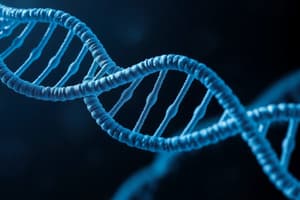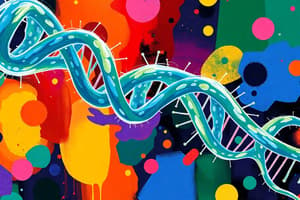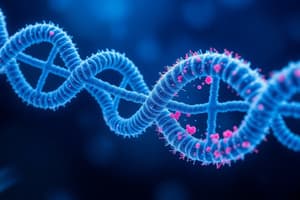Podcast
Questions and Answers
Which type of satellite DNA consists of repeats that extend over millions of base pairs and is primarily found in centromeres?
Which type of satellite DNA consists of repeats that extend over millions of base pairs and is primarily found in centromeres?
- Interspersed Repeat
- Satellite (correct)
- Microsatellite
- Minisatellite
What is the primary function of Alu elements within the human genome?
What is the primary function of Alu elements within the human genome?
- Act as markers for DNA fingerprinting
- Contribute to mitochondrial replication
- Serve as a source of genetic variation
- Play a role in unequal crossing over (correct)
Long Interspersed Nuclear Elements (LINEs) comprise what percentage of the nuclear genome?
Long Interspersed Nuclear Elements (LINEs) comprise what percentage of the nuclear genome?
- 3%
- 21% (correct)
- 10%
- 0.5%
Which mechanism is primarily utilized by Class I transposons such as LINEs for their mobility?
Which mechanism is primarily utilized by Class I transposons such as LINEs for their mobility?
Microsatellites are also known by which other term?
Microsatellites are also known by which other term?
What characteristic differentiates human protein-coding genes from prokaryotic protein-coding genes?
What characteristic differentiates human protein-coding genes from prokaryotic protein-coding genes?
Which statement about prokaryotic plasmids is accurate?
Which statement about prokaryotic plasmids is accurate?
What feature is unique to the human mitochondrial genome when compared with the nuclear genome?
What feature is unique to the human mitochondrial genome when compared with the nuclear genome?
Which of the following represents a key difference between human chromosomes and prokaryotic genomes?
Which of the following represents a key difference between human chromosomes and prokaryotic genomes?
Which statement is incorrect regarding the structural organization of eukaryotic chromosomes?
Which statement is incorrect regarding the structural organization of eukaryotic chromosomes?
What is the main substance that composes satellite DNA?
What is the main substance that composes satellite DNA?
What is the approximate size of the human nuclear genome compared to prokaryotic genomes?
What is the approximate size of the human nuclear genome compared to prokaryotic genomes?
Which aspect of prokaryotic gene arrangement is characteristic?
Which aspect of prokaryotic gene arrangement is characteristic?
Which statement best reflects the nature of genes within the eukaryotic genome?
Which statement best reflects the nature of genes within the eukaryotic genome?
What percentage of the human genome is estimated to consist of repeated sequences?
What percentage of the human genome is estimated to consist of repeated sequences?
What is the primary role of regulatory DNA sequences in the genome?
What is the primary role of regulatory DNA sequences in the genome?
Which of the following accurately describes introns in the context of eukaryotic genes?
Which of the following accurately describes introns in the context of eukaryotic genes?
What distinguishes the mitochondrial genome from the nuclear genome?
What distinguishes the mitochondrial genome from the nuclear genome?
Which best describes interspersed repeats in the genome?
Which best describes interspersed repeats in the genome?
How many protein-coding genes are estimated to be present in the human genome?
How many protein-coding genes are estimated to be present in the human genome?
Which statement is true regarding satellite DNA?
Which statement is true regarding satellite DNA?
What is true about the differences in genome size between Escherichia coli and humans?
What is true about the differences in genome size between Escherichia coli and humans?
Which of the following statements accurately describes repetitive sequences in the genome?
Which of the following statements accurately describes repetitive sequences in the genome?
What is characteristic of gene families in the context of repetitive DNA?
What is characteristic of gene families in the context of repetitive DNA?
Which chromosome is associated with the α globin family?
Which chromosome is associated with the α globin family?
How do interspersed repeats primarily differ from tandem repeats?
How do interspersed repeats primarily differ from tandem repeats?
Which type of DNA is primarily involved in replication processes within the mitochondria?
Which type of DNA is primarily involved in replication processes within the mitochondria?
Which of the following is NOT typically classified as satellite DNA?
Which of the following is NOT typically classified as satellite DNA?
What role do repeated sequences play in chromosomal structure?
What role do repeated sequences play in chromosomal structure?
The olfactory receptor gene family is an example of which aspect of genetic structure?
The olfactory receptor gene family is an example of which aspect of genetic structure?
Which characteristic feature distinguishes β globin genes from α globin genes?
Which characteristic feature distinguishes β globin genes from α globin genes?
Which type of DNA is responsible for nearby spatial arrangements and can influence gene expression?
Which type of DNA is responsible for nearby spatial arrangements and can influence gene expression?
Which characteristic is associated with the concept of genetic polymorphism?
Which characteristic is associated with the concept of genetic polymorphism?
What is a distinguishing feature of mitochondrial genomes compared to nuclear genomes?
What is a distinguishing feature of mitochondrial genomes compared to nuclear genomes?
What type of DNA primarily serves as a key tool for DNA profiling?
What type of DNA primarily serves as a key tool for DNA profiling?
Which of the following statements is true regarding interspersed repeats within genomes?
Which of the following statements is true regarding interspersed repeats within genomes?
In terms of sequence variation, which of these is considered a rare variant?
In terms of sequence variation, which of these is considered a rare variant?
Which statement accurately describes microsatellites?
Which statement accurately describes microsatellites?
What role does DNA replication play in genetic variation?
What role does DNA replication play in genetic variation?
Which statement best describes the relationship between genome size and species complexity?
Which statement best describes the relationship between genome size and species complexity?
Which of the following best describes a wild-type allele?
Which of the following best describes a wild-type allele?
Which of the following types of repeats can be classified as tandem repeats?
Which of the following types of repeats can be classified as tandem repeats?
What makes bacteria antibiotic resistant and how can it be transmitted to neighboring bacteria?
What makes bacteria antibiotic resistant and how can it be transmitted to neighboring bacteria?
What is the difference between DNA fingerprinting and Allele Tracking?
What is the difference between DNA fingerprinting and Allele Tracking?
Which type of organism has more non-coding/non-protein regions?
Which type of organism has more non-coding/non-protein regions?
What is true about the Nuclear Genome?
What is true about the Nuclear Genome?
Which satellite is found in centromeres where spindles attach (kinetochore)?
Which satellite is found in centromeres where spindles attach (kinetochore)?
Which satellite is used for DNA markers in DNA fingerprinting and allele tracking? This satellite also has telomeric repeats and is highly variable (6-64)
Which satellite is used for DNA markers in DNA fingerprinting and allele tracking? This satellite also has telomeric repeats and is highly variable (6-64)
Which satellite contains short tandem repeats (STRs) and simple sequence repeats (SSRs), may increase in length due to certain diseases, and can be used for DNA and allele tracking?
Which satellite contains short tandem repeats (STRs) and simple sequence repeats (SSRs), may increase in length due to certain diseases, and can be used for DNA and allele tracking?
What types of satellite DNA are considered variable tandem repeats?
What types of satellite DNA are considered variable tandem repeats?
What is true about Telomeres?
What is true about Telomeres?
What is true about Short Interspersed Nuclear Elements (SINE) for satellite DNA?
What is true about Short Interspersed Nuclear Elements (SINE) for satellite DNA?
What is an ALU element?
What is an ALU element?
What is true about Long Interspersed Nuclear Elements (LINE) of satellite DNA?
What is true about Long Interspersed Nuclear Elements (LINE) of satellite DNA?
What is SINE?
What is SINE?
Flashcards are hidden until you start studying
Study Notes
Prokaryotic Protein-Coding Genes
- Prokaryotic genes are arranged in closely spaced clusters.
- These genes lack introns.
- Regulatory regions are shown in green.
- Prokaryotic genomes are about 1/1000 the size of the human nuclear genome.
- Genes are densely arranged.
Eukaryotic Genes
- Eukaryotic genes have introns.
- Human nuclear genome is about 3.1 x 109 bp per genome.
- It contains approximately 19,000 - 20,000 protein-coding genes.
- Genes are sparse, about 1 gene per 100,000 bp.
- DNA is packaged up with histone proteins.
- Linear DNA is organized into 23 different pairs of chromosomes (2n, diploid), with 22 autosomal chromosomes and a sex pair that can be XX or XY.
Human Mitochondrial Genome
- Circular DNA with more than 10 copies per mitochondrion and more than 1000 copies per cell.
- Contains 16,500 bp per genome with 37 encoded genes.
- It is gene-rich, with approximately 1 gene per 445 bp.
- It is inherited maternally.
- The human mitochondrial genome lacks histones.
Satellite DNA
- Satellite DNA is classified based on the length of the repeat.
- Satellite: 171- 68 bp repeats spanning millions of bp. This is often found in centromeres.
- Minisatellite: 6 - 64 bp repeats, highly variable total repeat size (polymorphic). Minisatellites are used for DNA fingerprinting and allele tracking.
- Microsatellite: Aka, Short Tandem Repeats (STRs), Simple Sequence Repeats (SSRs); 2-, 3- or 4 bp units, with a highly variable total repeat size.
- Alu elements are the most abundant sequence in the human genome and can play a role in unequal crossing over.
Repetitive Sequences
- Long Interspersed Nuclear Elements (LINE): Most are ~6000 bp long.
- Only 0.5% to 0.1% of LINEs remain active.
- LINEs include genes for reverse transcriptase and an endonuclease.
- Class II transposons use a "cut and paste" mechanism and require “transposase.”
Human Genetic Variation
- Human genomic sequences average ~0.1% variation.
- Variations in sequence arise by mutation and then spread through the population during evolution.
- Alleles are different versions of an identified gene, typically differing by a small number of nucleotides.
- The wild-type allele is the most common allele for a gene within a population.
- Polymorphism is an allele that is less common than the wild-type allele but occurs more than 1% of the time.
- A variant refers to any change in DNA sequence.
- A rare variant is found at a frequency of < 1%.
Studying That Suits You
Use AI to generate personalized quizzes and flashcards to suit your learning preferences.



